HMS Prince of Wales hit her “official” top speed of 25 knots as her diesel generators and gas turbines were pushed to full throttle, say the Royal Navy.
According to BAE, the class has a maximum speed of 25 knots but typically in projects like this, the maximums are understated.
The top speed for this class of ship is much higher, with HMS Queen Elizabeth hitting around 32 knots on trials.
The source of this information is the automatic identification system (AIS) which is a tracking system used for collision avoidance on ships and by vessel traffic services. Information provided by AIS equipment, such as unique identification, position, course, and speed, can be displayed on a screen or in a simpler format on many websites.
Speaking to a naval architect involved in the programme, I was told regarding sister ship HMS Queen Elizabeth:
“While the vessel will never routinely cruise at that speed, ships of this size including bigger American supercarriers never do, she will be capable of this speed even when loaded as verified by recent builders trials. 32 knots however is likely the maximum, she’s not going to go any faster.”
According to the Royal Navy, it took almost all the 109 Megawatts of power – enough to meet the needs of a city the size of the carrier’s home of Portsmouth – the six engines generate to propel the 65,000-tonne warship along at full speed.
“The carrier is powered by four diesel generators and two gas turbines, run by the 170-strong marine engineering department – one third the size of the equivalent department on the Navy’s last conventional carrier, HMS Ark Royal, which left service 40 years ago.”
The Royal Navy added in a news release that it required another two miles of clear sea to bring the 280-metre-long aircraft carrier to a stop again – such is the momentum generated by the engines running flat out.



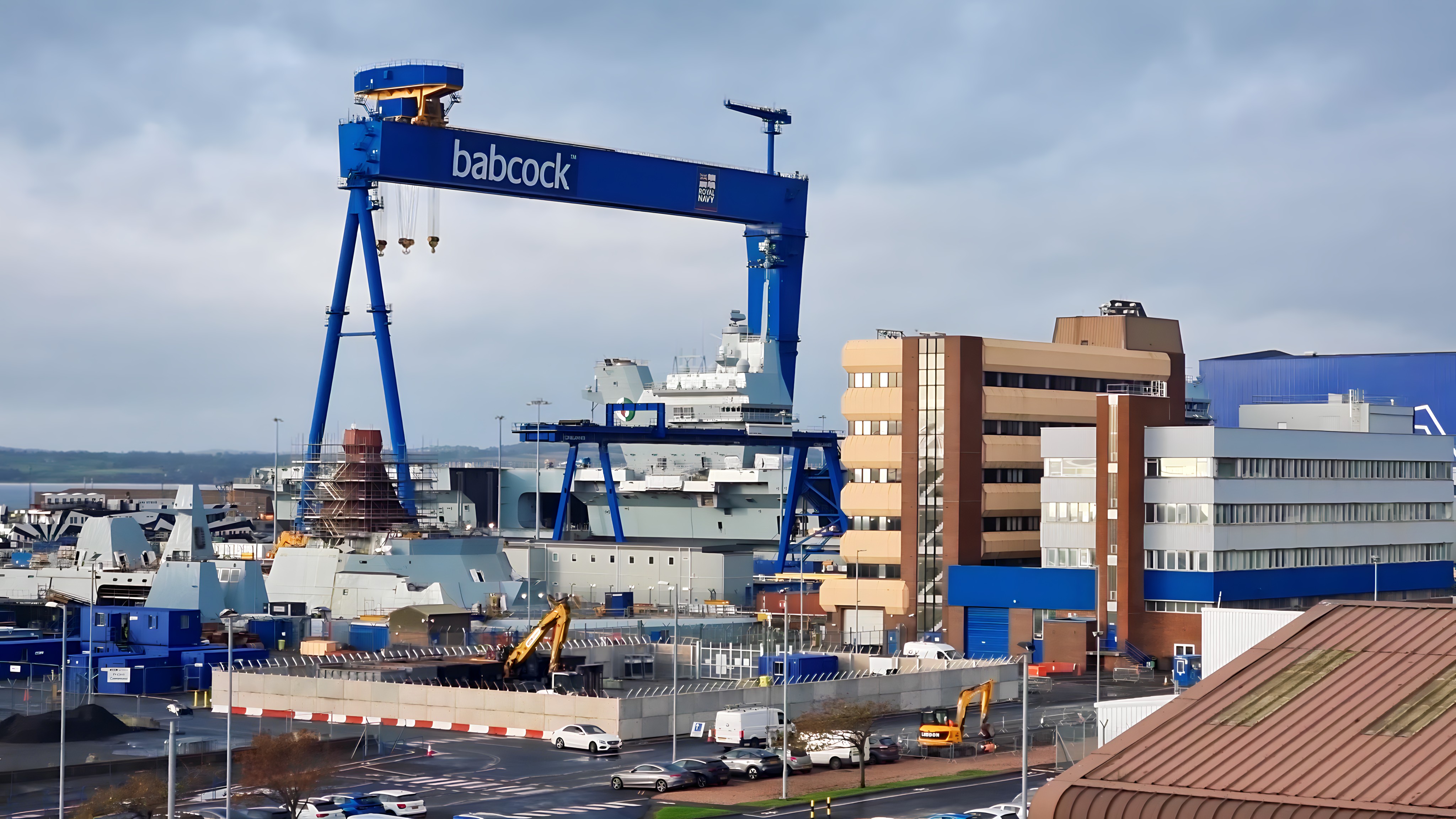
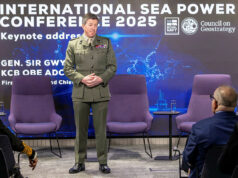
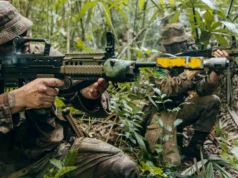

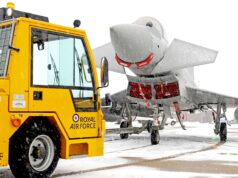
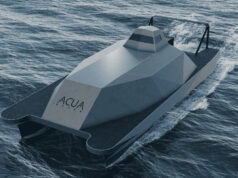
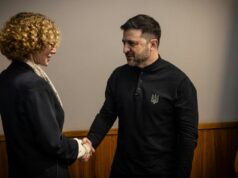




That looks like a tight turn for a big ship.
What you can’t really tell is whether they were going astern in the inboard shaft just before that photo was taken. Typically in these situations they will try every combination of shaft Revs and rudder angles to prove the theoretical turning circles and the start/stop distances. This is then collated in the ships book, and can then be used as a stick to beat the navigator when he makes a cock up bringing the ship in somewhere!
What I would really like to see is a video of the ship flat out and under 30 degrees of helm. Some of the pictures of the big American carriers are spectacular.
When aboard Ark Royal for the first time, I wondered what the seat belts on the bunk was all about. Soon found out later though and why nobody chose the top bunk. One phrase was torpedo evasion drills, boy that ship could turn. It must have been healing over by at least 45 degrees, anyway enough to make you fall out of bed.
I hope they had seat belts for the aircraft then.
With all this less manpower a third less engineers on HMS QE And POW than previous big carriers, and we have far less everything really, why can’t we see some increases in defence procurement, extra ships to replace some of the axed ones, extra troops to replace the many thousands axed! We must be saving loads compared to 14 years ago, we have far less submarines, ships, man power, helicopters, more than half of our jets gone half our helicopter force and all nimrods.
But no we have huge black holes everywhere! We should spend what’s needed not what they can get away with, i never hear ministers sticking up for the British millitary when campaigning to be MPs or PM. It’s a huge part of American elections and wins votes! Why do we accept having a small Army and far less escorts than say South Korea, Japan’s far ahead of us now in ships.Hell even turkey has massive amounts of more gear than the UK in certain key areas.. it’s a dam disgrace and we need to spend 3.5% of gdp now. I was hoping Boris would announce something great but a billion odd over how many years lol! It’s a start I suppose ose
It always bothers me that when we progressively slashed our defence budgets, apart from the generals, there was never a whimper. Nobody realised or cared. In the same timeframe, we saw health budgets balloon. Now when we would be happy with just a 0.5 or 1 % uplift, its “difficult” or “unlikely”. For one moment, I’m not saying health, education or other “social” budgets are not worthy, I’m just saying when we have slashed too far and really need an uplift, it shouldn’t be a big deal. I just hope the country does NOT find itself in the predicament that due to a poor economy, this isn’t possible
One of the issues is that most people just don’t care. I don’t mean that people are actively anti-defence, just unaware/ignorant or/and seeing greater problems/priorities in need of funding. Occasionally we see a bit of flag waving but never enough to make governments think about increasing funding. The Falklands was a classic example of short lived flag waving. The period after saw only serious drops in funding. There wasn’t even much made of the fact that the some of the ships sent to the Falklands were woefully unarmed due to poor funding. Another thing that makes life difficult for the navy, as an example, is the long term nature of building and equiping ships. There really is no way for a government to respond quickly to a unswing in public support. In the case of the Falklands the upswing in public support didn’t help as the assets were needed then, not in 2 years.
The government provides defence spending details which is accurate and up-to-date, I would suggest anybody interested in the UK’s armed forces should take a few minutes to have a look at these.
Agree Cam. It is disturbing that smaller Nations are overtaking us in the numbers game. In terms of army personnel and front line aircraft we are out of the top ten however on the other side our equipment is tops in many fields-aircraft, submarines, destroyers,Carriers and per tonnage the RN is still in the top division-PoW and QE equalling approximately 20 large escorts per displacement, and the Nuclear capability is an Ace in the pack although one cannot realistically see it ever being used except in the Doomsday scenario
Agree with all points Geoff.
We have another Ace in the pack. The Intelligence community, SS, SIS, GCHQ, and DI, hand in glove with the 5 eyes nations.
Indeed Daniele and of course the Special Relationship with our Cousins across the Atlantic 🙂 Hot day in Durban-high twenties and getting humid. Cheers
Pouring down here, cold and damp!
Cheers.
40 here and humid…2 more weeks and the rains apparently start for a couple of weeks… That will be fun!
Where are you Gunbuster?
Hi Daniele, I have posted a subject on this site maybe you can help me with regarding the size of our military compared to other nations defence budgets. The post has just been sent.
Many thanks.
George
Can’t be denied that Americans support their military far more than we do. Part of it, I think, is in the American psyche and their (well founded) self-belief in the military superiority of the USA. However, with regard to their politicians’ support of the military, a lot of it is ‘pork barrel’ politics. Politicians will support the military to the hilt if they think they can get a new air base, factory or support facility in their constituency. Back in the UK, the snowflakes would have a thrombie if they heard their local MP was campaigning for a new arms factory in their back yard. The twitterati would go into a frenzy, the MP would get death threats and would swiftly rethink his/her policy (well, you get my drift…).
“It’s a huge part of American elections and wins votes! Why do we accept having a small Army and far less escorts than say South Korea, Japan’s far ahead of us now in ships.Hell even turkey has massive amounts of more gear than the UK in certain key areas.“
The USA took over our role as world policeman, we used to have a 400 ship navy when we were in that position, the US needs those numbers for its role as the worlds number one global power, and because American success and prestige relies on this position it’s a vote winner, much like it was with us
South Korea and Japan dont get on well with their neighbours, one has a nuclear armed dictator on its border and the other has a nuclear armed country with the largest army in the world that hates its guts just across the water
Turkey has a tinpot dictator, has historic enemies next to it, and shares a border with war torn countries
We are a country in Europe surrounded by friendly nations, the worlds number one soft power so lots of friendly nations around the world, is best friends with the worlds policeman, and part of the most powerful mutual defence treaty in the world, spending money on defence is simply not a vote winner
Having said that, we are still short and what should be spent is exactly what’s needed for all our standing commitments currently not met, 2.5% written into law with the nuclear deterrent back into the treasury and pensions into the huge welfare budget would go a hell of a long way to getting us where we should be.
But in all honestly until we are either humiliated in a conflict or we get a PM that actually sells increased defence spending to the public it simply won’t happen, but the reasons are clear
Agree with all of that.
Question to the marine propulsion experts out there: 1. are marine engines like car engines, you need to travel 20,000 miles to run them in properly? 2. if QE or PoW needed to get somewhere quickly with escorts, how long could this group maintain a speed faster than cruising (for how long could they sail at 30knts) and what would the consequences of that be at sustained speed?
The old Ark Royal did a high speed run to allow Buccaneers to over fly Belize sometime in the 80s I think. I used to have a book on it but lost it over time, but what she did was very good at the time.
I read that book and remember the high speed dash!
The book is Phoenix Squadron by Rowland White, published by Bantam Press. The actual incident was on the 28th Jan 1972. It’s a very good read and shows just how effective a very brief show of force can be. Another parallel would be when the Argentines were sabre rattling in the late 70’s , the Foreign Secretary was David Owen and I believe he caused a SSN to be deployed. So when the Argentine suggested that it was all bluff they were merely asked to put their ship to sea and see what happened. Very effective and not a shot fired. Shame something similar didn’t happen in 1982.
Thanks for that I will now find the book and download it.
Nick – yes that was in 1977,it was called Operation Journeyman,it prevented a Falklands Invasion but as History proved it only lasted 5 years.
LOL I just dug it out of my storage box.
Actually, something similary did happen – HMS Conquerer sank the Belgrano. The Argentine navy then stayed in port for the rest of the conflict.
Absolutely. It’s just a pity that they didn’t think of it in February of 1982 rather than May. A bit of deterrence would have saved an awful lot of lives.
What a daft line of thought, Nick. Real ‘arm chair admiral’ stuff.
You are entirely right, the trouble with hindsight is that it is always 20/20. There is a huge difference between realpolitik on one side and the practicalities of the situation when it occurs.
Thats a great book, they cut it a bit close on the return and had to fly into US airspace, were intercepted, but carried on to return with no avgas left. Ark Royal was brilliant that operation.
It was imminant cuts to the RN that led the Argentines to believe the UK was withdrawing from the S Atlantic & an invasion could work. Thatcher gained loads of support for fighting a war her policies actually caused.
High speed runs use up fuel very quickly. A fuel capacity that may last for 5,000+ miles at economical cruising may be emptied in 1,000 miles or less. It’s a very expensive activity. Flat-out top speeds are rarely used. The ability to steam into the wind at 30 knots is desirable for carriers though, to increase the lift for launching aircraft.
The manufacturing tolerances used on modern diesels and advances in oil and bearing manufacture mean that engines do not need running in, they will have bench load tested them in the factory anyway. Gas turbines need nothing other than load testing either. the fuel consumption would be the only limiting factor on maintaining a high speed over s given length of time – as long as the shaft bearings are adequately cooled then she could do that all day.
Most engines are already “run in” during the trials period. DGs get serviced on an hours run schedule and as they are modular to a large extent running in is not an issue. GTs again not an issue.
Range is dependent on consumption. Faster= less range. You need a Fleet tanker with you to do high speed running and you will RAS every couple of days as needed.
High speed will get you there quickly but you need to balance that against not being able to do anything whilst at high speed. High speed in even moderate weather puts the upper deck out of bounds, flight ops are restricted, maintenance goes out the window, even eating is difficult as the galley and messes is getting thrown all over the place. It also wears out the crew. Fighting against a rolling and pitching ship rapidly takes it out of you.
I did some very high speed transits on FFs…for example from South Georgia to the Falklands for a CASEVAC and secondly from Guz in response to the Canadian sub in difficulties in the Irish sea. It was horrendous.. Everyone was told to stay in bed and for 1- 2 days we ate pot mess as that was the limit of cooking from the chefs. Nothing happened for a couple of days during the transit Maintenance, forget it, Flying forget it. When we did arrive we where low on fuel and needed to RAS as we where below the Min fuel limit.
This class hitting 32 knots is impressive.
Yes but I doubt she could keep that speed up very long before she ran out of petrol. So just for short dashes.
Haha-before she ran out of petrol! Not to mention the cost of it-must need a ‘few bob’ to fill her up!
Has it got stop/start fitted like my Fiat 500?
Howsit Herodotus-imagine if your Fiat 500 needed two miles to stop!! 🙂
I think the original 500, with drum brakes, actual did need 2 miles!
As I remember it that is a total fallacy, truth is you could never get them started. I do have very fond memories of the Alfa Sud mind a beautiful car to drive, beautiful flat 4 engine just bloody awful to own like the Fiat.
Hmmm…you have a point about the 5oo. As I remember, the Alfa Sud was a fantastic car marred by corrosion issues. A colleague of mine had one…we were based on the Clyde…you could visibly track the rust line as it ate the vehicle!
I had a 1981 Sprint Veloce-beautiful styling, nice motor but the sills were paper thin and rusted within a year. The GTV’s were much better-I had a South African developed 3 litre with six down draft Dellorto carbs. Was a machine. Sorry for digressing Mr editor!
All that style and panache…..I love Italian design. But then wasn’t Mr Issigonis, creator of the mini, Italian as well?
Indeed-along with Michelotti who also had a hand in designing some Brit cars
I’ve just done a quick back of fag packet calculation. QE runs on marine diesel, which seems to be running at about £300/tonne. Given that the new Tide tankers can pump fuel at 2000/tonnes/hour a 1 hour RAS costs the Queen £600,000. Rather pricier than a Fiat 500, and much more reliable!
Ah…but we will see. Going to be interesting to see how reliable these carriers turn out to be…given their 50 year in service life expectation. How easy is it to replace the gas turbines and heavy engineering components, is major surgery needed?
Purely a guess but id imagine swapping out Major Machinery would be relatively easy considering the size of the Carriers.
Yes, you are probably right…think I remember seeing a schematic that placed the big generator sets quite high up in the superstructure compared to old steam turbines in the bowels of the ship!
Thanks for the info Nick.
A T22 on both Olympus at 30+ knots drank something like 7 galls per second. You didn’t do that very often as you would run out of go go juice really quickly hence you stayed on the far more economic Tynes for a lot of the time.
Still think it’d have been preferable to have installed miniature nuclear plants on these like th French and Americans. That’s a lot of diesel, lots of support ships and nowadays an enormous carbon footprint
Im not sure the footprint for most people near them in a conflict feels quite like that relative balance mind.
It will be interesting to see if the French choose nuclear or not for their new one.
Would also be interesting to know if there is any effort to do as the Yanks are doing on their America class and have the ships and all the assets on them eventually using the same fuel.
Would also have seriously limited foreign port calls…and having very pissed of matelots!
Yep! Nuclear = no runs ashore.
Regarding the carbon footprint the MOD is actually far better than commercial operators. F76 DIESO is used for maritime fuel in DGs and GTs onboard. (Helos use AVCAT which is more refined). Being a high purity distillate it does not have the impurities that something like heavy fuel oil or furnace fuel oil has.
All UK warships do have a log that records the carbon footprint and it is a legislative requirement for the MEO to ensure that the engines burn clean and do not dump black smoke out.
“Yep! Nuclear = no runs ashore.”
Er…how come? As far as I know, the US Navy doesn’t restrict it’s guys from going ashore simply because they serve on a nuclear powered ship?
As an Australian i think we should organize a lease where we pay to have one carrier based here for 6 Months or like japan with US contribute to upkeep of Royal navy vessels in a British Pacific Fleet , Canada who is having they’re own Pacific dilemma and the Kiwis could also supply crew and resources . It would mean savings over all with more personal and assets with savings attributed to a larger fleet and the purchasing power that would provide .
Not a bad idea, but would have been better if Australia had bought some F35B
Hi folks hope are all well.
Does look impressive and good to see this and helps push forward the “global Britain” as mentioned by out political leadership. Its about time they started to keep the flag flying, and continue to uplift the defence budget, increase numbers in all areas of our magnificent military.
In one of the posts here there is mention of Turkey having larger numbers in military. How is this achieved with a defence budget of approximately $14bil compared to to the UK’s of $65 bill. Can some of you help me with this question please as many of you have the expertise in this area.
All the best.
Many factors I guess, and these are just off my head and I’m happy to be corrected as I know next to nothing of the Turkish military.
What logistics do they have? As in can their forces deploy across the world as ours can, with full range of enablers.
Is their large army made up of poorly trained conscripts?
What pay and conditions compared to UK personnel?
No Trident, Vanguard, or AWE, which takes 30 plus billion of our ten year equipment budget.
No Gold plated assets like SSNS.
How much on R & D?
Do they have the many bases the UK has, and the related costs?
How much do they spend on training, flight hours, spare parts, and other costs. Our military has a certain standard of professionalism and international standing, despite its size.
Are their people paid less, do their infrastructure costs cost less? 800 million was spent upgrading just RAF Marham I recall?
Do they include pensions in their budget?
Do they spend 2 billion plus on their version of UKSF?
Do they have carriers?
Do they spend silly money on very small amounts of kit, like we do, which is 1st rate but of high cost?
Do they waste 1 billion on FRES without a single vehicle to show for it?
Do they spend 350 million on 5 poorly armed OPVs which we all read should cost far less.
Do they have an often incompetent Mod?
Do they buy OTS or do they develop their own, with the costs that entails?
Do they have a blue water navy?
Do they have the wide ranging c3 infrastructure, cyber, and intelligence networks the UK has as part of our world class intelligence community, which cost a great amount if money?
Do they have an equivalent to SKYNET?
Do they have an equivalent to GOSCC, which cost, along with other related upgrades to Basil Hill, over 650 million pounds, for 1 site?
Numbers matter, but so do capabilities. I feel a balance is needed and the UK often has the know how and capability but in such small numbers do to the costs. Just some suggestions?
I think a question to be asked is whether the defence cuts of 2010 were intended to be permanent or a temporary measure as the government grappled with the deficit.
I would say officially they would say temporary. But there have been plenty of cuts before 2010 and the new reduced number of RN surface escorts and subs with each reduction was always the new benchmark, with no mentions of increases, since FLF 95.
Building 13 T26 as just one example. There were 16 T23 and the 4 T22 B3’s, and, further back, the Batch 2 22’s, Boxer, Beaver, Brave, London, Sheffield, Coventry which all vanished from 95 onwards.
Yes I agree. Once one government makes a cut, it sets an unwelcome precedent for the next government to follow.
Unfortunately, almost all defence procurement projects are complicated and take many years from conception to completion, often spread over several governments. They are therefore often vulnerable to short term needs and political objectives. As you say, the various changes in the T26 order has left us assuming that 8 ASW frigates is enough, just as we assume 6 T45s are all we need, and 138 F35s are more than adequate for the FAA and RAF.
That being said, the last 20 years has been a very challenging time for defence procurement, perhaps on a par with the 1960s. The peace dividend at the end of the Cold War, the focus on counter-terrorism and counter-insurgency operations that followed the World Trade Centre attacks in 2001 and the 2007-2008 financial crisis have all had an impact.
But I would also say that during this time the MOD’s procurement strategy was cavalier in its approach – many of the projects initiated between 1995 and 2010 were high risk, with a good chance of going over budget and behind schedule, while at the same time existing kit was kept in service for longer and decisions to proceed with their replacements were frequently delayed, leaving a small margin of error in the event a project went behind schedule.
It has definitely left us short in terms of fast jet aircraft, surface combatants, submarines and armoured units. The land forces have also been pushed and pulled around and they haven’t even been given any new kit yet! But, we have managed to hold onto the full range of our capability, albeit with a temporary gap for maritime patrol and naval fast jet aviation. Hopefully, though, going forward, we can learn from the problems we encountered in the last 20 years.
The 1960s was a bad time for defence procurement, but the 1970s were arguably a great success at a time of tremendous economic upheaval. Following the well publicised cancellations of programmes such as TSR2, the CVA01 and various STOVL concepts, the MOD took a more realistic approach to equipment purchases. As a result, the Armed Forces received kit that did the job that was asked of it without breaking the bank. Much of the kit that came into service at that time would go on to serve with distinction in the Falklands, the Gulf War, Bosnia, Kosovo, Sierra Leone, Afghanistan and Iraq, not to mention Northern Ireland and West Germany.
Hopefully the MOD can do the same again going forward in the 21st century. It needs to be realistic in what it can afford to buy and what can be delivered for the price; it needs to look for commonality where possible, to maximise cost savings; it needs to stop postponing procurement programmes for the sake of it (although often one gets the feeling this is a Treasury problem) and it needs to get projects turned around quicker to avoid them being shut down by a new government.
Excellent post.
Cheers Daniele, I think it’s good that you make the point above about the capabilities we have which other nations don’t despite them spending around the same amount as we do.
Hopefully going forwards we can get numbers up. Although the Army as ever seems to get forgotten. What is happening with Boxer and Ajax? I haven’t read much about them for a while…
I probably know as much as you.
Boxer was supposedly to be a 500 vehicle order, but nothing concrete. Worriedly, there are just a handful of variants, and not the wide selection required for a ( ideally ) all wheeled Strike Brigade, from fire support to ATGW to recc.
Ajax is scheduled to go into the Strike Brigades. 2 Regiments each. 1 is as a recc formation, the other is being termed as “Medium Armour” which is asking for disaster in my layman opinion.
This then hamstrings the Brigades giving their main firepower on tracks, while the battalions are to be wheeled.
It also hamstrings the remaining Armoured Brigades which under current plans drop from 5 units to 3, and leaves them without the armoured recc replacement for Scimitar which was bought to furnish their integral armoured recc formations.
I hope these plans change.
Thanks for the re-cap. Maybe I just haven’t noticed much, but it seems that unlike other projects related to the RAF or the Navy, these don’t get too much put out about them. Not sure if that’s because with a new ship class or a new fleet of aircraft, those are seen to be big, complex items, whereas APCs and IFVs and recce vehicles, by virtue of their being ground based, are not seen in the same light, even though they are every bit as important and the govt is spending serious money of them.
Or maybe both projects have fallen into a massive black hole either in money terms or financial terms, and the MOD don’t want to draw attention to it!
Many thanks for such a comprehensive reply. I did suspect those areas you mention were the reasons. And as you rightly say numbers do not make up for poor quality and levels of training and conditions.
Much appreciated
Thanks
George
……And wait for the “we should’ve gone for nuclear propulsion, the Carrier would’ve been faster then” critics to crawl out from under their bridges and moan about the fact that we’ve gone for a conventional propulsion system……zzzzzzzzzz.